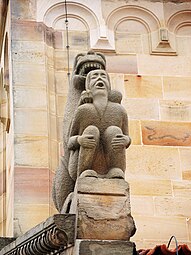Acroterion


An acroterion, acroterium, (pl. akroteria)[1] is an architectural ornament placed on a flat pedestal called the acroter or plinth, and mounted at the apex or corner of the pediment of a building in the classical style.[2] An acroterion placed at the outer angles of the pediment is an acroterion angularium (angulārium means ‘at the corners’).
The acroterion may take a wide variety of forms, such as a statue, tripod, disc, urn, palmette or some other sculpted feature. Acroteria are also found in Gothic architecture.[3] They are sometimes incorporated into furniture designs.[4]
Etymology
[edit]The word comes from the Greek akrōtḗrion (ἀκρωτήριον 'summit, extremity'), from the comparative form of the adjective ἄκρος, ("extreme", "endmost") + -τερος (comparative suffix) + -ιον (substantivizing neuter form of adjectival suffix -ιος). It was Latinized by the Romans as acroterium.[5] Acroteria is the plural of both the original Greek[6] and the Latin form.[7]
According to Webb, during the Hellenistic period the winged victory or Nike figure was considered to be "the most appropriate motif for figured akroteria.”[1]
Gallery
[edit]- Ancient Greek acroterion as Nike, by Paionios, 421 BC, marble, Archaeological Museum of Olympia, Olympia, Greece
- Ancient Greek acroterion of a Nereid on horseback, c.380 BC, marble, National Archaeological Museum, Athens
- Ancient Greek akroterion, 350–325 BC, marble, Metropolitan Museum of Art, New York
- Akroterion of the grave monument of Timotheos and Nikon, 350–325 BC, marble, Metropolitan Museum of Art
- Ancient Greek acroteria from a temple of Artemis, 330-300 BC, marble, Archaeological Museum of Epidaurus, Epidaurus, Greece,
- Ancient Greek acroteria of the Tomb III, Agios Athanasios, Greece, 325-300 BC
- Simplified Ancient Greek acroteria of the pediment on an honorary decree, c.300-250 BC, bronze, National Archaeological Museum, Athens[8]
- Romanesque acroterion of the Église Saints-Pierre-et-Paul de Rosheim, Rosheim, France, unknown sculptor or architect, c.1150
- Renaissance acroteria of the Villa La Rotonda, outside Vicenza, Italy, designed by Andrea Palladio, 1566-1590s[9]
- Neoclassical acroteria with mascarons on the Grave of Lupin-Roux family, Loyasse Cemetery, Lyon, sculpted by Pierre-Marie Prost, c.1830
- Neoclassical acroteria of a window of the Großer Blumenberg, Leipzig, Germany, designed by Albert Geutebrück mid-19th century
- Neoclassical pediment with acroteria of the Grave of Alexandrina Grejdanescu and Barbu Grejdanescu, Bellu Cemetery, Bucharest, Romania, unknown architect or sculptor, c.1871
- Japanese acroterion, illustrations by Abel Guérineau, 1887
- Beaux Arts acroterion of the Collège Franklin (Boulevard Louis-XIV no. 5), Lille, France, unknown architect or sculptor, c.1900
- Beaux Arts acroterion above a window of Strada Grigore Cobălcescu no. 14, Bucharest, unknown architect or sculptor, c.1900
- Beaux Arts acroterion above a window of Strada Bocșa no. 2, Bucharest, unknown architect or sculptor, c.1900
- Art Nouveau acroterion of a stove in the Mița the Cyclist House (Strada Biserica Amzei no. 9), Bucharest, possibly designed by Nicolae C. Mihăescu,[10] 1908
- Art Deco acroterion of the Dinicu Golescu Entrance of the Northern Railway Station, Bucharest, designed by Victor Gh. Ștephănescu, 1935[11]
- Postmodern acroterion of the Harold Washington Library, Chicago, by Hammond, Beeby & Babka, 1991[12]
- Postmodern acroteria on the pediment of the Children's Museum of Houston, Houston, US, by Robert Venturi, 1992[13]
- New Classical acroteria on the pediment of the Maitland Robinson Library, Downing College, Cambridge University, Cambridge, UK, by Quinlan Terry, 1992
See also
[edit]References
[edit]- ^ a b Webb, Pamela A. (1996). Hellenistic Architectural Sculpture: Figural motifs in western Anatolia and the Aegean islands. Madison, Wisconsin: The University of Wisconsin Press. p. 26.
- ^ "Acroterian". Merriam Webster.
- ^ Harris, Cyril M. (1983). Illustrated Dictionary of Historic Architecture. Courier Corporation. p. 5. ISBN 9780486244440.
- ^ "acroterion - architecture".
- ^ "acroter". Oxford English Dictionary (Online ed.). Oxford University Press. (Subscription or participating institution membership required.)
- ^ McCarver (ed.). "Glossary of architectural terms". McArver Ancient History. Greek Architecture. Porter-Gaud School. Archived from the original on 8 September 2006. Retrieved 26 January 2021.
- ^ Smith, Philip (1875). "Acroterium". In Thayer, Bill (ed.). A Dictionary of Greek and Roman Antiquities. University of Chicago. Retrieved 26 January 2021.
- ^ Smith, David Michael (2017). Pocket Museum - Ancient Greece. Thames & Hudson. p. 235. ISBN 978-0-500-51958-5.
- ^ Hopkins, Owen (2022). Reading Architecture - A Visual Lexicon. Laurence King. p. 35. ISBN 978-1-52942-034-0.
- ^ Mariana Celac, Octavian Carabela and Marius Marcu-Lapadat (2017). Bucharest Architecture - an annotated guide. Ordinul Arhitecților din România. p. 85. ISBN 978-973-0-23884-6.
- ^ Mariana Celac, Octavian Carabela and Marius Marcu-Lapadat (2017). Bucharest Architecture - an annotated guide. Ordinul Arhitecților din România. p. 171. ISBN 978-973-0-23884-6.
- ^ Gura, Judith (2017). Postmodern Design Complete. Thames & Hudson. p. 77. ISBN 978-0-500-51914-1.
- ^ Eleanor Gibson. "Seven of Robert Venturi's best postmodern projects". dezeen.com. Retrieved 25 June 2023.
External links
[edit]- "Acroterion". Encyclopædia Britannica. article 9003592.






![Simplified Ancient Greek acroteria of the pediment on an honorary decree, c.300-250 BC, bronze, National Archaeological Museum, Athens[8]](http://upload.wikimedia.org/wikipedia/commons/thumb/5/5c/%CE%92ronze_inscribed_plaque_with_an_honorary_decree_of_the_Eleians_for_the_Olympic_victor_Demokrates_from_the_island_of_Tenedos%2C_written_in_the_Eleian_dialect%2C_from_the_Sanctuary_of_Zeus_at_Olympia%2C_300-250_BC_%2828382489002%29.jpg/170px-thumbnail.jpg)

![Renaissance acroteria of the Villa La Rotonda, outside Vicenza, Italy, designed by Andrea Palladio, 1566-1590s[9]](http://upload.wikimedia.org/wikipedia/commons/thumb/a/a8/06-Villa-Rotonda-Palladio.jpg/383px-06-Villa-Rotonda-Palladio.jpg)








![Art Nouveau acroterion of a stove in the Mița the Cyclist House (Strada Biserica Amzei no. 9), Bucharest, possibly designed by Nicolae C. Mihăescu,[10] 1908](http://upload.wikimedia.org/wikipedia/commons/thumb/2/2c/Art_Nouveau_polychrome_tiled_stove_in_the_Mi%C8%9Ba_the_Cyclist_House%2C_Bucharest_%2804%29.jpg/330px-Art_Nouveau_polychrome_tiled_stove_in_the_Mi%C8%9Ba_the_Cyclist_House%2C_Bucharest_%2804%29.jpg)
![Art Deco acroterion of the Dinicu Golescu Entrance of the Northern Railway Station, Bucharest, designed by Victor Gh. Ștephănescu, 1935[11]](http://upload.wikimedia.org/wikipedia/commons/thumb/4/41/Bucharest%2C_Gara_de_Nord_%2815483566168%29.jpg/378px-Bucharest%2C_Gara_de_Nord_%2815483566168%29.jpg)
![Postmodern acroterion of the Harold Washington Library, Chicago, by Hammond, Beeby & Babka, 1991[12]](http://upload.wikimedia.org/wikipedia/commons/thumb/2/28/Chicago_%283392204396%29.jpg/340px-Chicago_%283392204396%29.jpg)
![Postmodern acroteria on the pediment of the Children's Museum of Houston, Houston, US, by Robert Venturi, 1992[13]](http://upload.wikimedia.org/wikipedia/commons/thumb/8/8d/HoustonChildrenMuseum.JPG/340px-HoustonChildrenMuseum.JPG)
